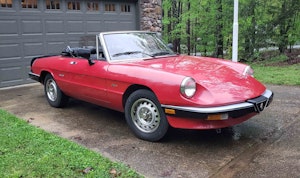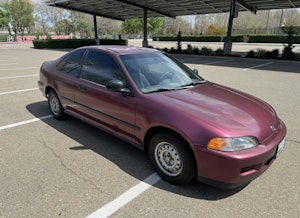Media | Articles
The winter road trip: Bitten by originality
I spent a lot of time getting ready to take a winter road trip to Greer, South Carolina, in my 1972 BMW 2002tii (aka Louie), so that the car could be included the BMW Car Club of America Foundation’s exhibit, “The Icon: 50 Years of the BMW 2002.” I’ve also spent a lot of time writing about it, sharing the logic behind what tools and parts I should take, with that advice rooted in “The Big Six” things likely to strand you (ignition, fuel delivery, cooling, charging, belts, and ball joints).
Well, the trip is now complete. Louie and I made it from Boston to South Carolina, and I also made it back home. The car is now in the BMW CCA Foundation museum, where it will spend nearly a year. But, as is the case with most thousand-mile road trips in 46-year-old automobiles, the trip was not without a little drama.
First, the weather was a concern. Snow had been forecast for the entire eastern seaboard the day before I was planning to leave. I almost advanced the trip a few days to beat the snow, but I ultimately decided to wait it out, as rain and warmer weather was forecast to follow. In the end, the snow was lighter than expected, and the rain and warmth wiped all traces of it from the roads. The first part of the drive was in an early morning mist that made the roads wet, but I never felt like I was driving in a spray of salt. I think the snow was so light that the roads hadn’t been salted at all, something for which I was grateful. Still, I was glad for fresh wiper blades and a functional windshield washer.
20180316172447)
As I described a few weeks ago, I’d discovered that the root cause of the car’s persistently-leaky valve cover gasket was that the head was actually cracked at the upper left corner. The crack radiated upward from the boss for the valve cover stud to the corner nearest the firewall. When you say “cracked head,” people think about cracks in the combustion chamber that affect the running of the car. This wasn’t that, but it was cracked nonetheless, and quite seriously. I’d sealed the valve cover gasket with “The Right Stuff” from Permatex, and it appeared to be holding, but I imagined catastrophic failure, smelling oil, and opening the hood to find a corner of the head completely missing. So, the entire drive down, every time I stopped to fill the tank or to empty my own, I dutifully raised the hood and ran a paper towel under that corner of the valve cover. It came up dry.
Marketplace
Buy and sell classics with confidence
One time, though, while I was checking the oil, my eye was drawn to the car’s Kugelfischer injection pump, and I was startled to find it damp on the left side. There wasn’t the overwhelming smell of gas associated with an active leak, but when I ran a paper towel through the dampness and sniffed it, it did smell like fuel. I wondered if the dampness was residual, as I’d swapped radiators in the car before the trip, which required disconnecting and repositioning the fuel filter. The injection pump has rubber seals at the top. I’d replaced these last year, so it would be unusual for them to leak. There are also thin copper crush washers beneath the delivery valves. If these are loosened, it sometimes requires quite a bit of re-positioning and force to get them to seal, so I didn’t want to disturb them. I settled for checking that everything was tight, wiped off the dampness, started the car, verified that there were no fuel leaks, and vowed to watch it carefully. I didn’t see any dampness the entire drive down.
20180316172504)
I also noticed that the fuel pump, which I’d replaced a year ago, seemed a little loud, sounding occasionally like a large slow horsefly was loose in the trunk. A friend, a professional mechanic who I visited the first night of the trip, listened to it and offered that if the sound came and went while I was driving, it could be that the tools and parts I had in the trunk were pressing on the trunk panel, which in turn was pressing on the rubber hose from the top of the tank that feeds the fuel pump. I thought that was a great and highly likely explanation.
The only other problem I experienced was a slight vagueness to the steering. I’d replaced the car’s tie rods and center track rod back in the fall. After this kind of work, you need to align the front end. For the first time ever, I tried to adjust the toe-in myself using the string method you can find on youtube. That by itself was spectacularly unsuccessful, but through trial and error, I managed to dial it in. It was very satisfying, actually, as I could feel the alignment go from obviously toed too far out and twitchy, to obviously toed too far in and scrubbing, to “if I hadn’t just replaced the tie rods and I drove this car, I wouldn’t sense anything was wrong with the front end.” In addition, I was thinking of buying a set of Bilstein HD struts and shocks for the car, and I reasoned that if professional alignment was necessary, I should do it after the struts were in.
That was sound logic, but I didn’t get around to installing the struts before the road trip, never got it professionally aligned, and found that driving the car hundreds of miles is different from a one-exit test drive. The steering wasn’t twitchy, just vague; it felt like it could use a skosh more toe-in. I almost stopped and tweaked it, which is trivial to do—use a 13mm ratchet and wrench to loosen up both ends of the tube holding one of the tie rods, rotate it a small amount, and re-tighten—but I imagined that I’d first get it wrong and turn the tube the wrong way, toeing it out, not in, and that what would ensue was an iterative process requiring multiple stops that would add an hour onto what was already two days of all-day driving. I let it be.
So, all minor stuff. I was a car guy in his beloved vintage car, blasting over the stretches of interstate that hopscotch back and forth over the Appalachians, living the dream. Louie hummed along beautifully for 1130 of the 1150 miles. Until he didn’t.
I was about 20 miles from my hotel, on a congested divided highway with construction occupying the breakdown lane, when the car begin stumbling and bucking. Such things are almost always either ignition problems or fuel delivery problems. Because of the dampness I’d previously found on the injection pump, I assumed it was the latter, but there wasn’t the overwhelming gas smell I’d associate with a seal or fuel line blowing. Then I recalled the business of the loud fuel pump, and thought perhaps the pump was failing. Or there was a restriction, like a clogged fuel filter or screen. Or weight in the trunk had shifted so that the fuel line was really being pinched. There’s a saying that if a car feels like it’s running out of gas, it probably is, at least at some level. Dying fuel pumps and clogged fuel filters often exhibit that symptom. So I waited with trepidation for the other shoe to drop. Fortunately, it didn’t; although the car stumbled, it kept running—a good thing since the road I was on did not have anywhere I could safely pull over.
As I approached an exit a few miles later, I thought for a moment that I could probably make it to the Foundation and sort the problem out there. But then I thought, hell, maybe it’s just something as simple as a plug wire that fell off. I took the exit, where fortunately there was a gas station and convenience store with a large parking lot.
When I opened the hood, I smiled as I saw that a plug wire had indeed fallen off. The Bakelite plug connector for #3 plug was resting right on the exhaust manifold. Good thing I’d stopped; it probably would’ve melted. Well, we’ll just pop that puppy back on. I folded a paper towel so I wouldn’t burn myself, picked up the connector, and tried to slide it back on the top of the #3 plug.
I then had a conceptual disconnect when the connector wouldn’t seat on the top of the plug. What the…?
I looked inside the connector, and saw the problem. The metal barrel that actually slides over the top of the plug had broken off from inside the connector. It was doubtless sitting on top of the spark plug, something I verified by removing the plug.
20180316172539)
20180316172555)
At this point, I must refer back to a story I wrote last month, “The Price of Originality.” I specifically mentioned how I prized the fact that Louie had his original plug wires, including the two-year-only coil wire with the pick-up “wart” that fed a connector intended for a dealer engine analyzer. These were typically thrown in the garbage the first time the plug wires were changed, so the fact that Louie still has them is a sign of his originality. But there was no question that here, right here, I was looking at a situation where my desire to maintain originality—the plug wires and their 46-year-old Bakelite connectors—had caused a failure. What I should have done, and what I’d done on other long drives with Louie, was installed a modern set of plug wires for the drive, and swapped them at the destination if I wanted to show off his old bits. In the push to ready him for both the drive and the museum stay, I’d simply forgotten.
20180316172652)
Fortunately, although I didn’t have a full set of plug wires with me, I had thrown a spare plug wire and Bakelite connector into the box of ignition components in the trunk at the last minute. These connectors simply screw into the end of the plug wire. I unscrewed the broken one, installed the replacement, pulled the snapped-off metal piece off the end of the plug, reassembled everything, started the car, revved it to be certain the stumble was gone, then knocked off the remaining 15 or so miles to my hotel near the Foundation.
20180316172624)
As I drove, I laughed. It was, in fact, the perfect failure. The car didn’t actually die somewhere unsafe. Driving with the problem didn’t damage the car. I saw the apparent cause of the problem the moment I opened the hood. The root cause of the problem was just different enough from the apparent problem to cause a few seconds of conceptual disconnect, but not enough to strand me. I had the part I needed in my trunk. I was on the road again in 15 minutes. And, even if I hadn’t been able to fix it, I was within free towing distance of my final destination anyway. Perfect.
Most important, it was just enough of a problem to make the trip an adventure. I mean, really, who wants to say “I drove a 46-year-old car more than a thousand miles, and absolutely nothing went wrong.” Where’s the adventure in that?
So Louie is now safely ensconced in the BMW CCA Foundation museum for the “50 Years of the BMW 2002” exhibit that opens to the public on May 19. I take pride in the fact that it is one of a handful of cars that was driven there instead of trailered, and of the cars driven, it came the farthest, by far.
20180316172706)
But when I drive him home after the exhibit is over… He’ll definitely have new plug wires.
***
Rob Siegel has been writing the column The Hack Mechanic™ for BMW CCA Roundel Magazine for 30 years. His new book, Ran When Parked: How I Road-Tripped a Decade-Dead BMW 2002tii a Thousand Miles Back Home, and How You Can, Too, is available here on Amazon. In addition, he is the author of Memoirs of a Hack Mechanic and The Hack Mechanic™ Guide to European Automotive Electrical Systems. Both are available from Bentley Publishers and Amazon. Or you can order personally inscribed copies through Rob’s website: www.robsiegel.com.









